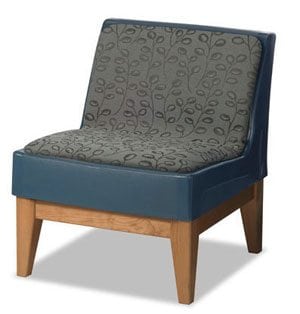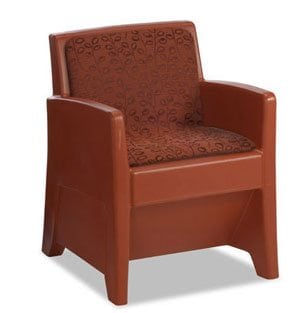Upholstered Chairs for Healthcare Facilities: When to Use and What Materials to Consider
 Research shows that the look and feel of a healthcare facility can assist in the recovery and healing process for patients and help create a sense of home in these environments. That is why today’s architects and interior designers who work in the healthcare sector look for design options and furniture solutions that provide warm colors and residential aesthetics. And what says home more than an upholstered chair that provides comfort for your back and supportive seating for long periods of time.
Research shows that the look and feel of a healthcare facility can assist in the recovery and healing process for patients and help create a sense of home in these environments. That is why today’s architects and interior designers who work in the healthcare sector look for design options and furniture solutions that provide warm colors and residential aesthetics. And what says home more than an upholstered chair that provides comfort for your back and supportive seating for long periods of time.
However, in continuous-use facilities such as those in the healthcare industry — where variables such as sanitation, safety and intensive use must be considered — the question is not only “whether” you should include upholstery, but also “what” materials should be used for the space where furniture is needed.
When to upholster
The question of whether or not to use upholstery on chairs in your facility comes down to one consideration: What is most critical in the environment where the furniture will reside? If aesthetics and comfort are the main concerns – think waiting rooms and staff areas – then facilities will want to include upholstery that is inviting and non-institutional and that creates a sense of home. Upholstered furniture in these areas keeps staff comfortable and makes the wait times and patient behavior in emergency rooms more manageable.
Additionally, behavioral healthcare facilities – and general healthcare facilities that include mental health units – can also use upholstery on chairs in non-critical areas such as dayrooms and areas where therapy is conducted and comfortable seating and residential aesthetics are mandatory. In these areas upholstery may not only provide comfort, but also help in the healing process by creating a sense of home for patients.
What Materials to Choose
In your home you may have a big, commercial-grade leather or fabric recliner that is perfect for relaxation. But have you ever spilled a cup of coffee or glass of wine on that chair? It probably wasn’t easy to clean. Now imagine upholstered chairs in healthcare environments where sanitation and constant use have to be considered. And there is no way around it: Furniture in healthcare facilities has to fend off bodily fluids, salt solution, chlorine, other chemicals and a steady stream of people in what are sometimes 24/7 environments. In short, healthcare grade materials are imperative in these facilities. The upholstery used on Norix Furniture chairs include contract vinyl, 100 percent Polyurethane, 50 percent cotton / 44 percent polyester woven Crypton® and 100 percent solution-dyed nylon.
When not to upholster
As previously mentioned, healthcare and behavioral healthcare facilities have to consider sanitation and infection control when they choose furniture for their environments. Bodily fluids – blood, urine, body oils, among others – are common challenges.
As an additional safeguard, these facilities can choose not to include upholstery and still create an aesthetically pleasing environment that evokes a sense of home. In these cases, facilities need to choose comfortable chairs with a contemporary design that come in a variety of colors so the furniture can be matched to the environment.
 For example, the Norix Forté™ series of chairs includes an upholstered and non-upholstered option. Forté™ includes a lounge chair (above, right) that is slightly reclined and a guest chair (left) that is pitched slightly forward for comfortable seating at a table. The chairs have a modern look and feel – even without the upholstery option – and are a far cry from institutional-grade healthcare furniture from decades past.
For example, the Norix Forté™ series of chairs includes an upholstered and non-upholstered option. Forté™ includes a lounge chair (above, right) that is slightly reclined and a guest chair (left) that is pitched slightly forward for comfortable seating at a table. The chairs have a modern look and feel – even without the upholstery option – and are a far cry from institutional-grade healthcare furniture from decades past.
Forté™ is fabricated in one-piece rotationally molded polyethylene that is lightly textured. It’s easy to clean and is chemically resistant. These chairs can also be weighed down or ganged together to avoid movement while still providing a residential feel along with the warm colors and safety features that are needed in behavioral and general healthcare settings.
For related resources, please visit the following web pages:
Norix Furniture Behavioral Healthcare Products
White Paper: Planning and Design of Behavioral Healthcare Facilities
Design Guide: Color and The Human Spirit
Case Study – Mercy Hospital, Miami FL
Dustin Coleman is a brand journalist for Norix Furniture and a contributor to the Safe Environments blog.